It's been a decade since Xplore Technologies introduced a brand-new platform, and that's a good long time even in the rugged computing industry where product cycles are long and longevity matters. But while Xplore's venerable line of ultra-rugged iX104 tablets just propelled the company to its best year ever, Xplore is now adding a second product line, the RangerX, to address a broader part of the burgeoning tablet market. So what is the RangerX?
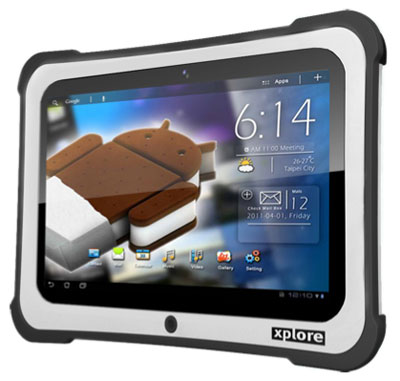
That would be a 10.1-inch rugged Android tablet. It has roughly the same footprint as the company's iX104 Windows tablets, but is only half as thick and weighs less than half as much. It costs much less, too, and it uses the same projected capacitive multi-touch interface as consumer tablets and smartphones. No pen. Rather than a junior addition to the existing iX104, the RangerX is a ruggedized implementation of a consumer tablet. One configured for industrial markets and the type of work encountered on the job, be that in the field, warehouse, truck or anywhere else.

As far as physical specifications go, the RangerX measures 11.1 x 7.2 inches (282 × 183 mm) and is 0.85 inches (22 mm) thick. That's a bit larger and quite a bit thicker than consumer media tablets in this class. With 2.2 pounds, the new Xplore tablet weighs a pound more than a consumer media tablet, but much less than traditional Windows-based rugged tablets. In terms of design and build, the RangerX uses a magnesium alloy frame with elastomer edge and corner protection like the iX104 line, but it has its own distinctive look.
The display measures 10.1 inches diagonally, has 1366 x 768 pixel resolution (16 : 9 aspect ratio), and a bright 500 nit backlight. 1366 x 768, to many known as 720p, is more than the original iPad and works well with Android on this size screen. The display uses IPS LCD technology, which means it offers perfect viewing angles from all sides. Direct-bonding of layers and special optical coatings minimize reflectivity, making the screen quite sunlight-readable and thus suitable for work both indoors and outdoors. The image below shows the RangerX next to a 3rd-gen iPad outdoors under noon sunshine in a partially shaded spot, both at full brightness.
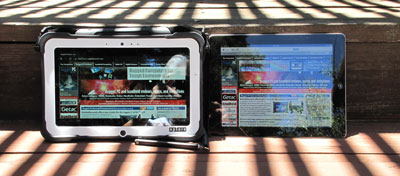
Projected capacitive multi-touch works best with a smooth glass surface that extends well beyond the display itself and the RangerX has that, so it is pleasant to operate. Android, of course, has been optimized from the start for procap touch, and there are none of the usability issues Windows classic has with touch. Do note, however, that procap doesn't work with gloves on or in the rain. Also note that while most procap consumer tablets have a completely flat front surface, the glass on the RangerX extends about a quarter inch beyond the LCD perimeter, then there is a very slight rise to the white bezel around the screen, and after another 5/8th of an inch the raised rubber protective guard.
The RangerX is powered by a 1.5GHz Texas Instruments OMAP 4470 processor that uses a dual-core ARM Cortex-A9 and two ARM Cortex M3 cores,  as well as a PowerVR SGX544 GPU. This same processor is used in high-end Kindle and Nook tablets, as well as in Archos and some other tablets and smartphones. This is a good match as in our initial hands-on, the RangerX felt quick and responsive. RAM is 1GB of LPDDR2 SDRAM, and mass storage comes in the form of 32GB of eMMC NAND Flash. That can be complemented with up to 32GB in a user-accessible micro-SD card slot, and, optionally, by another up to 128GB micro SD in an internal slot. For power, user-replaceable 35.5 watt-hour battery is good for up to ten hours of operation.
as well as a PowerVR SGX544 GPU. This same processor is used in high-end Kindle and Nook tablets, as well as in Archos and some other tablets and smartphones. This is a good match as in our initial hands-on, the RangerX felt quick and responsive. RAM is 1GB of LPDDR2 SDRAM, and mass storage comes in the form of 32GB of eMMC NAND Flash. That can be complemented with up to 32GB in a user-accessible micro-SD card slot, and, optionally, by another up to 128GB micro SD in an internal slot. For power, user-replaceable 35.5 watt-hour battery is good for up to ten hours of operation.
Onboard connectivity consists of a full USB 2.0 port, a micro USB 2.0 port, audio, and micro HDMI-out. Optionally available are HDMI-in and an RJ45 LAN jack. On the wireless side is dual band 802.11a/b/g/n WiFi, Bluetooth 4.0, integrated GPS, and optional 4G LTE mobile broadband.
The RangerX also has ambient light and G sensors, a user-facing HD webcam, and a 5-megapixel rear-facing autofocus camera with LED illuminator for documentation. The rear camera can record up to full 1080p HD video, and the camera, unlike in most mobile devices, is good and fast enough for actual work.

The RangerX has significantly more onboard I/O than most tablets this light and compact. The illustration below shows the two I/O blocks on the left side of the unit. Two caveats here: micro USB and HDMI ports are a bit fragile, and the protective doors are fingernail busters to open.
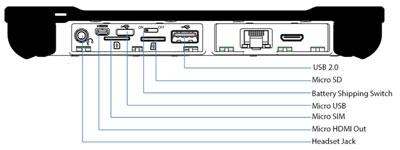
Xplore especially emphasizes the availability of HDMI-in, as that feature is often required by satellite, cable, broadband and telecommunications providers to validate and diagnose installations or services issues on-site.
Analyzing the construction of the Ranger X tablet, there's a PCS bottom "bucket" on which is mounted a magnesium alloy midframe to provide rigidity and extra protection. Then comes the LCD assembly and on top of that a rubber protective guard that slightly raises above the display plane along the sides and more on all four corners to provide extra protection.
For ruggedness, Xplore says the device successfully passed the MIL-STD-810G transit drop test of 26 4-foot drop to plywood while operating. And while the procedure does not require it, Xplore managed to pass all the tests with one single unit. The RangerX carries IP65 sealing, where the "6" stands for being dustproof and the "5" for the ability to handle low pressure water jets from all directions. The tablet can operate in a very wide temperature range of -4 to 140 degrees Fahrenheit (-20 to +60 Celsius), enough for virtual any conceivable deployment.
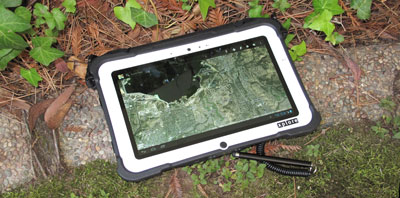
Note that at its introduction, the RangerX is configured with Android 4.0.4, codenamed "Ice Cream Sandwich."  Android has gone through several dozen iterations and versions, each with certain features and capabilities. In addition, there's an Android Compatibility Definition Document, a Compatibility Test Suite (CTS) and Google's GMS certification that determine which Android devices may use the Google Play store and some of the official Google applications. The initial version of the RangerX does not include the GMS module. However, while our (p)review unit did not have Google Play, it did have Maps, Chrome, GMail, and also provided access to the Amazon Android app store that has a large wealth of directly downloadable apps. Xplore did say they are preparing for Android 4.2.2 as well as GMS certification.
Android has gone through several dozen iterations and versions, each with certain features and capabilities. In addition, there's an Android Compatibility Definition Document, a Compatibility Test Suite (CTS) and Google's GMS certification that determine which Android devices may use the Google Play store and some of the official Google applications. The initial version of the RangerX does not include the GMS module. However, while our (p)review unit did not have Google Play, it did have Maps, Chrome, GMail, and also provided access to the Amazon Android app store that has a large wealth of directly downloadable apps. Xplore did say they are preparing for Android 4.2.2 as well as GMS certification.
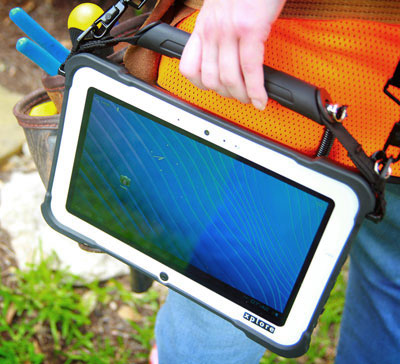
With the RangerX, Xplore Technologies complements its existing line of ultra-rugged iX104 tablets with an entirely new and exceptionally well done product family that greatly broadens and expands Xplore's reach in the rugged market. This bodes well for Xplore. Given the immense popularity of tablets, there is substantial opportunity for a product that offers business and industry the media tablet experience in a tougher, more durable version, and at a reasonable and competitive cost.
Our initial impression of the Xplore RangerX is very favorable. Stay tuned for a full review.



